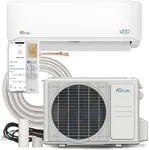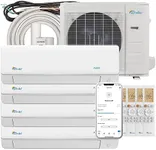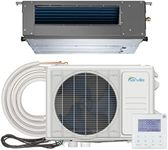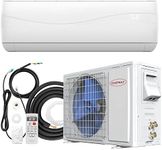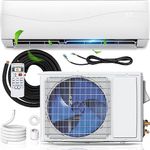Buying Guide for the Best Mini Splits
Choosing the right mini-split system is all about matching your needs with the features and capabilities of the unit. Mini-splits are a popular choice for heating and cooling individual rooms or spaces without the need for ductwork. To find the best fit, you should consider the size of the area you want to control, your climate, and any special features that might make your life easier. Understanding the key specifications will help you make a confident and informed decision.BTU Rating (Cooling/Heating Capacity)The BTU (British Thermal Unit) rating tells you how much heating or cooling power the mini-split can provide. This is important because a unit that's too small won't effectively control the temperature, while one that's too large can waste energy and may not remove humidity properly. BTU ratings are usually divided into ranges: small rooms (6,000–9,000 BTU), medium rooms (12,000–18,000 BTU), and large spaces (24,000 BTU or more). To pick the right BTU rating, measure the square footage of your space and consider factors like ceiling height, insulation, and sun exposure. Matching the BTU rating to your room size ensures comfort and efficiency.
Number of ZonesThe number of zones refers to how many separate indoor units the system can support, each with its own temperature control. This is important if you want to heat or cool multiple rooms independently. Single-zone systems are for one room or area, while multi-zone systems can handle two or more spaces. If you only need to control the temperature in one area, a single-zone system is enough. For whole-home or multi-room solutions, look for a multi-zone system that matches the number of spaces you want to manage.
SEER and HSPF Ratings (Energy Efficiency)SEER (Seasonal Energy Efficiency Ratio) measures cooling efficiency, and HSPF (Heating Seasonal Performance Factor) measures heating efficiency. Higher numbers mean better energy savings and lower utility bills. SEER ratings typically range from 13 to 25+, and HSPF from 7 to 13+. If you live in a region with hot summers or cold winters, higher efficiency ratings can make a noticeable difference in comfort and cost. Choose a system with higher SEER and HSPF ratings if energy savings and environmental impact are important to you.
Noise LevelNoise level, usually measured in decibels (dB), tells you how loud the indoor and outdoor units will be during operation. This matters if you plan to install the mini-split in a bedroom, office, or quiet space. Lower dB values mean quieter operation. Typical indoor units range from 19 to 40 dB, while outdoor units are usually a bit louder. If you are sensitive to noise or want a peaceful environment, look for models with lower noise ratings.
Compressor Type (Inverter vs. Non-Inverter)The compressor type affects how the mini-split adjusts its output. Inverter compressors can change speed to match the demand, leading to more consistent temperatures, quieter operation, and better energy efficiency. Non-inverter compressors turn on and off at full power, which can be less efficient and noisier. If you want smoother temperature control and lower energy use, choose a system with an inverter compressor.
Special Features (Smart Controls, Air Filtration, etc.)Many mini-splits come with extra features like Wi-Fi connectivity for remote control, advanced air filtration, dehumidification, or programmable timers. These features can add convenience and improve air quality. If you value being able to control your system from your phone, want cleaner air, or need specific scheduling, look for models that offer these options.
